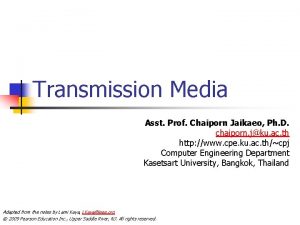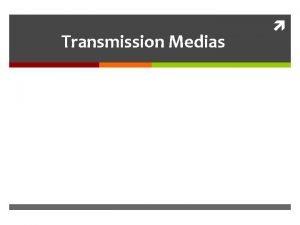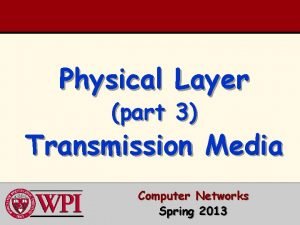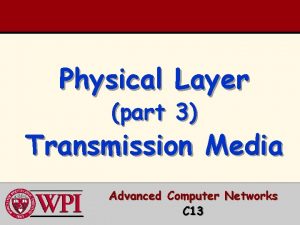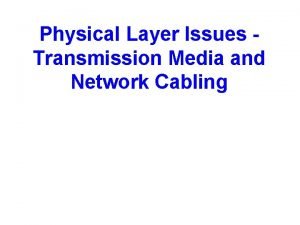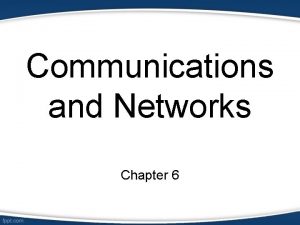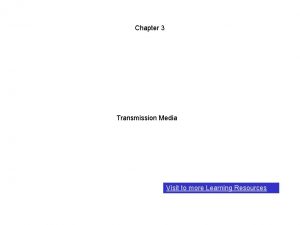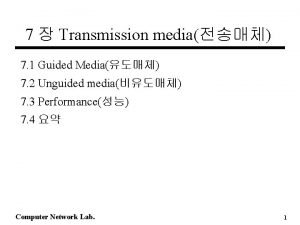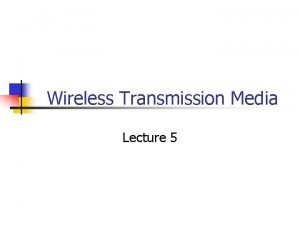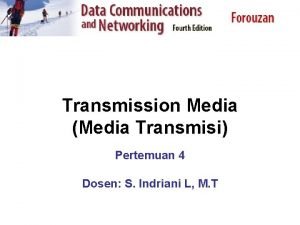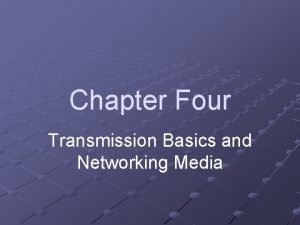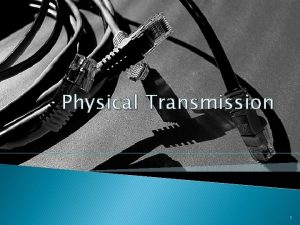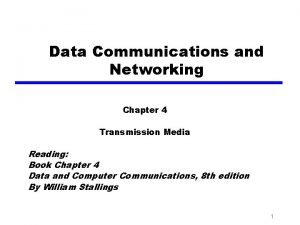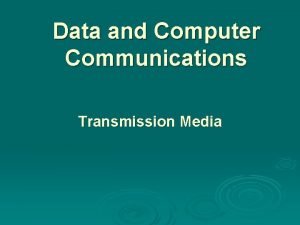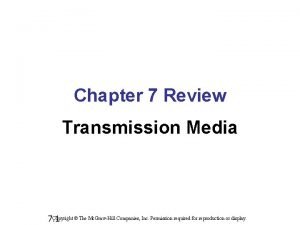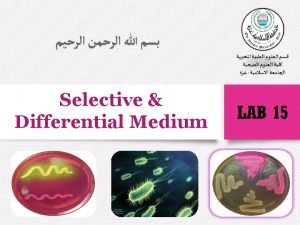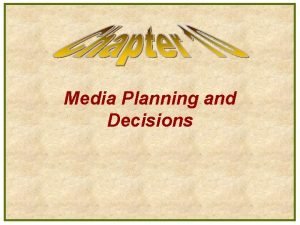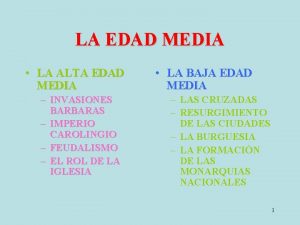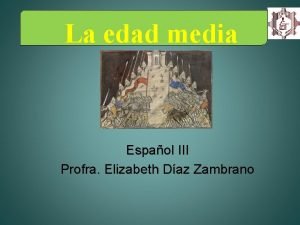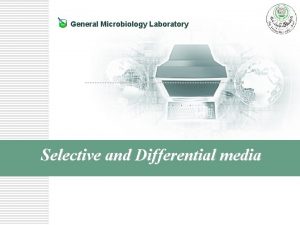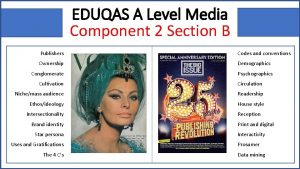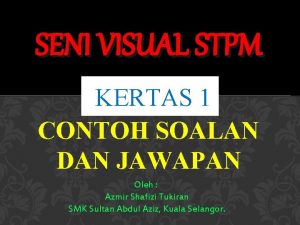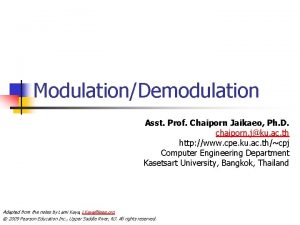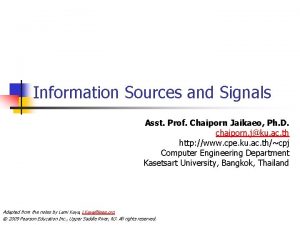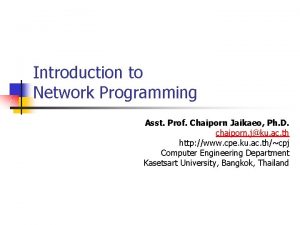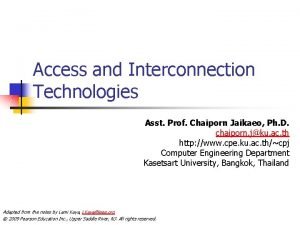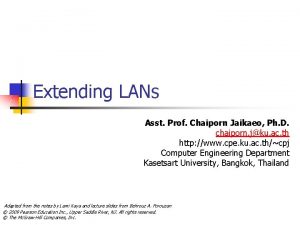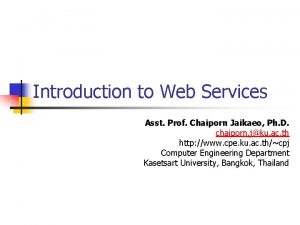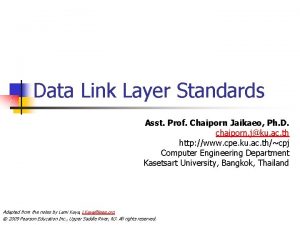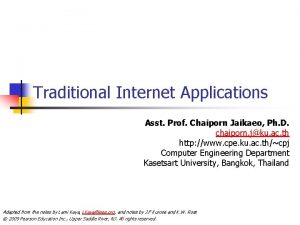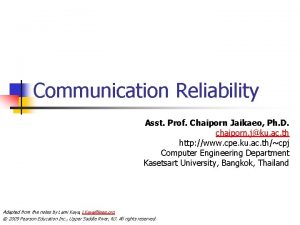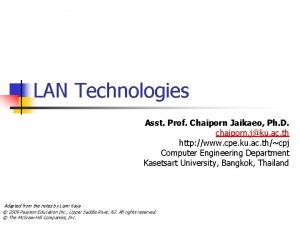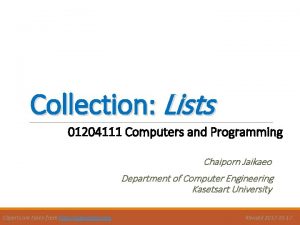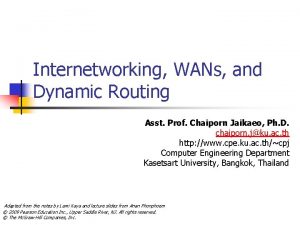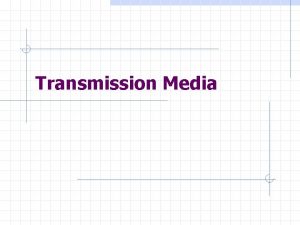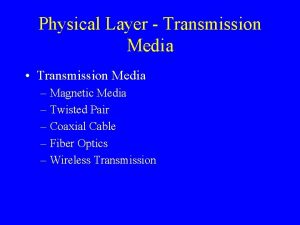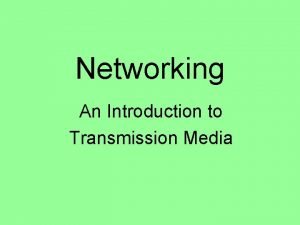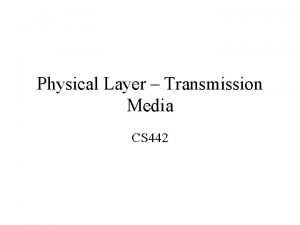Transmission Media Asst Prof Chaiporn Jaikaeo Ph D


























- Slides: 26

Transmission Media Asst. Prof. Chaiporn Jaikaeo, Ph. D. chaiporn. j@ku. ac. th http: //www. cpe. ku. ac. th/~cpj Computer Engineering Department Kasetsart University, Bangkok, Thailand Adapted from the notes by Lami Kaya, LKaya@ieee. org © 2009 Pearson Education Inc. , Upper Saddle River, NJ. All rights reserved.

Medium and Physical Layer

Classification of Media Guided Unguided

Noise n n Noise Undesirable signals added between the transmitter and the receiver Sources: n n Heat in cables Electromagnetic radiation

Widely-Used Copper Wiring n Twisted pair n n n Unshielded twisted pair (UTP) Shielded twisted pair (STP) Coaxial

Twisted Pair Copper Wiring

UTP Cables n Usually consist of several pairs

Shielded Twisted Pair Cables

Coaxial Cables

Categories of Twisted Pair Cables

Optical Fibers LED or Laser Diode Photodiode

Types of Optical Fibers

Optical Fibers vs. Copper Wires n Optical fibers n n Immune to electrical noise Less signal attenuation Higher bandwidth Copper wires n n n Lower cost Less expertise and equipment needed Less easily broken

Infrared (IR) Communications n IR is a form of electromagnetic radiation n n Similar to visible light But invisible to human eyes Used in TV remote controls Can reflect from smooth, hard surfaces

RF Communications n n n RF – Radio Frequency Most common form of unguided transmission Can traverse long distance and penetrate objects such as walls and buildings

Electromagnetic Spectrum RF range 1 k. Hz 1 MHz 1 GHz 1 THz Visible light

Satellite Communications n Classified by orbit types n n n Low Earth Orbit (LEO) Medium Earth Orbit (MEO) Geostationary Earth Orbit (GEO) http: //telecomencyclopaedia. com

GEO Communication Satellites n GEO satellites appear stationary on the sky n Orbit distance is 35, 785 km

GEO Sat: Example n How long does it take a signal to travel from a ground station to another ground station via a GEO satellite? n Given that light speed is 3 108 m/s

Measuring Transmission Media n Two most important characteristics of a transmission medium are: n n Propagation delay Time required for a signal to traverse the medium Channel capacity (bandwidth) Maximum data rate that medium can support

Data Rate: Noiseless Channels n Nyquist Theorem D = 2 Blog 2 K n n n D – Data rate in bps B – Bandwidth in Hz K – number of signal levels

Example We need to send 265 kbps over a noiseless channel with a bandwidth of 20 k. Hz. How many signal levels do we need? Solution We can use the Nyquist formula as shown: 265, 000 = 2 20, 000 log 2 K = 6. 625 K = 26. 625 = 98. 7 levels Since this result is not a power of 2, we need to either increase the number of levels or reduce the bit rate. If we have 128 levels, the bit rate is 280 kbps. If we have 64 levels, the bit rate is 240 kbps.

Data Rate: Noisy Channels n Shannon Capacity C = Blog 2(1+SNR) n n n C – Capacity (maximum bit rate) in bps B – Bandwidth of the channel in Hz SNR – Signal-to-Noise Ratio

Example A telephone line normally has a bandwidth of 3000. The signal-to-noise ratio is usually 3162. Calculate theoretical highest bit rate of a regular telephone line. This means that the highest bit rate for a telephone line is 34. 860 kbps. If we want to send data faster than this, we can either increase the bandwidth of the line or improve the signal-to-noise ratio.

Measuring Power Levels n Difference often measured in decibel (d. B) n n Negative d. B Signal power gets attenuated (reduced) Positive d. B Signal power gets amplified

Summary n n Transmission media and noise Guided transmission n Unguided transmission n n Copper wiring: UTP, STP, coaxial Optical fibers Infrared communications Radio frequency (RF) communications Satellite communications Characteristic of transmission media
 Copper wiring
Copper wiring What are the two types of transmission media?
What are the two types of transmission media? كبيل
كبيل Transmission media in computer network
Transmission media in computer network Physical transmission media used for network cabling
Physical transmission media used for network cabling What are the two types of transmission media?
What are the two types of transmission media? Transmission media in data communication
Transmission media in data communication Guided media in computer network
Guided media in computer network What is a wireless transmission media
What is a wireless transmission media Transmission media
Transmission media Physical layer transmission media
Physical layer transmission media Transmission basics and networking media
Transmission basics and networking media Physical transmission media
Physical transmission media Physical transmission media
Physical transmission media Data transmission media
Data transmission media Transmission medium
Transmission medium Name the two major categories of transmission media
Name the two major categories of transmission media Selective vs differential media
Selective vs differential media Contoh rancangan media
Contoh rancangan media Cost per rating point
Cost per rating point 6 characteristics of people media
6 characteristics of people media Invasiones en la alta edad media
Invasiones en la alta edad media Cuadro comparativo de la alta y baja edad media
Cuadro comparativo de la alta y baja edad media Hot and cold media
Hot and cold media Selective and differential media
Selective and differential media A level media vogue
A level media vogue Stpm seni sem 1
Stpm seni sem 1
